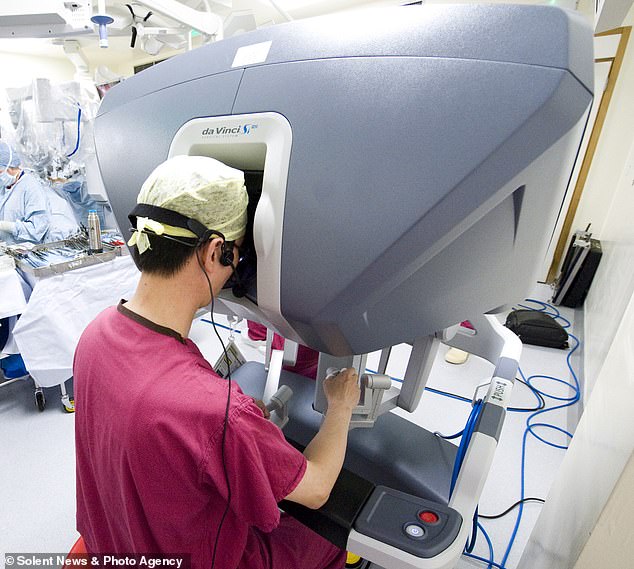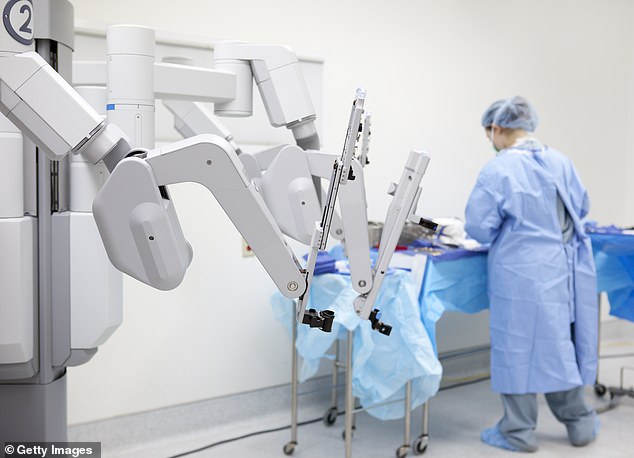A surgical robot burned a hole in a Florida woman’s small intestine during surgery, causing a deadly internal leak, a lawsuit filed by her husband claims.
Sandra Sultzer, 78, of Boca Raton, died in 2022 after a procedure to treat her colon cancer the previous year, which was performed with a ‘da Vinci’ robot.
The four-arm machine is activated by a doctor operating a camera and a surgeon who manipulates the robot’s arms from a console using a joystick and pedals.
But the lawsuit alleges that a fault allowed stray electrical power to emanate from robotic arms used to cut body tissue and burn his internal organs without the knowledge of the surgical team.
The da Vinci robot is an independent cart equipped with four arms. One arm holds a camera, or laparoscope, and the surgeon operates the other three “hands” by placing his fingers in small sets of loops.

Doctors performing surgery with the robot operate the arms from behind a console.
The lawsuit adds that this is not the first time that da Vinci robots have caused undue harm, and claims that the company behind the device, Intuitive Surgical Inc., “has also received thousands of reports of injuries and defects.”
Sandra Sultzer had surgery at Baptist Health Boca Raton Regional Hospital in September 2021 to treat her colon cancer.
Surgeons used the da Vinci surgical robot, an independent cart equipped with four arms.
One arm holds a camera, or laparoscope, and the surgeon operates the other three “hands” by placing fingers in small sets of loops behind a console.
Each arm is equipped with forceps, scissors, scalpels and other surgical tools, and can make incisions the size of a dime.
Precise movements generally result in less blood loss and trauma to the surgical site than open surgery with a larger cut.
The arms are wrapped with small rubber sleeves to prevent electricity from leaking to areas of the body outside the very precise surgical site, but the lawsuit alleges that the sleeves had cracks that allowed electrical currents to escape.
This, the lawsuit alleges, is what caused a hole to burn in Mrs. Sultzer’s small intestine.
The burn as a result of electrical radiation, known as arc flash, occurred outside the doctor’s field of vision, so it went unnoticed.
A hole in the small intestine releases digestive enzymes and bile that can lead to infection. If that infection spreads, the person can go into septic shock.
The lawsuit said: “If ISI had safely designed its product so that stray electrical energy would not burn the insides of patients without the surgeons’ knowledge or control, the injury to Ms. Sultzer’s small intestine would not have occurred. , and she have not died.’
In addition to alleging defects in the product, the lawsuit said the company failed to adequately train doctors on how to effectively use the device, increasing the chances of a potentially fatal error during surgery.

The robot’s arms are wrapped in rubber sleeves to prevent electricity from radiating. But thousands of medical device reports submitted to the FDA have found cracks or indentations in those sheaths, meaning electrical currents can leak into external tissues.
This is not the first time problems have arisen with defective rubber bushings.
Among reports of problems and defects to the Food and Drug Administration about the multimillion-dollar robot, “the most dangerous injuries arose from burns to internal organs caused by the discharge of electricity, caused by the robot’s instruments inside the patient.”
Intuitive Surgical said da Vinci robots have been used in about 12 million procedures with overwhelming success.
But at the same time, between 2008 and 2018, more than 20,000 da Vinci-related adverse events were filed with the Food and Drug Administration, according to an analysis of medical device reporting data by NBC News.
More than 2,000 recorded incidents involved injuries and 274 incidents resulted in deaths.
Additionally, nearly 17,000 events were identified as device malfunctions, ranging from minor failures to more serious problems, such as robotic arms deviating uncontrollably and cases where insulation dislodged inside patients’ bodies.
The FDA investigated growing reports of problems with the robots in 2013 and found that the company had “withheld information from the FDA, secretly recalled defective parts, and ignored known patient injuries in its design process for critical da Vinci instruments.” .
He Solar Sentinel reported that in 2023 alone, the number of adverse events related to the da Vinci device recorded in the database amounted to 3,098.
Intuitive Surgical did not respond to a request for comment from DailyMail.com, but told NBC in 2018: “Our training, systems and technologies reflect and are based on our commitment to patient safety, which is why we offer a comprehensive training program and intensive training on our technology depends on the capabilities of the surgeon, and we also strongly recommend that they continue training throughout their careers.
“As with any medical device manufacturer, we are only permitted to train on our technology; by law, we cannot train on the clinical practice or clinical application of our technology.”


